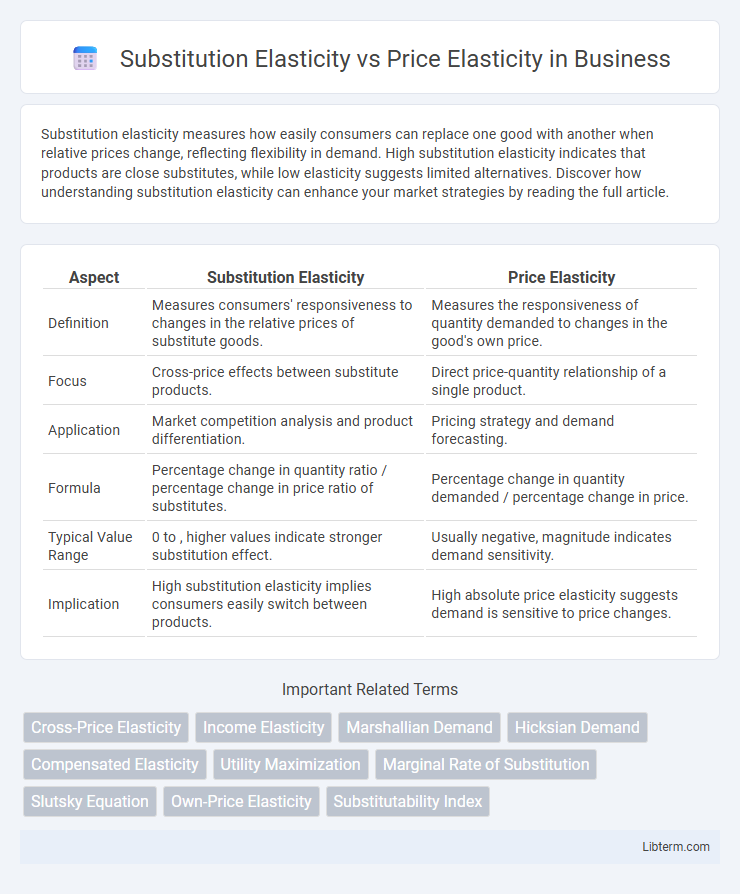Substitution elasticity measures how easily consumers can replace one good with another when relative prices change, reflecting flexibility in demand. High substitution elasticity indicates that products are close substitutes, while low elasticity suggests limited alternatives. Discover how understanding substitution elasticity can enhance your market strategies by reading the full article.
Table of Comparison
| Aspect | Substitution Elasticity | Price Elasticity |
|---|---|---|
| Definition | Measures consumers' responsiveness to changes in the relative prices of substitute goods. | Measures the responsiveness of quantity demanded to changes in the good's own price. |
| Focus | Cross-price effects between substitute products. | Direct price-quantity relationship of a single product. |
| Application | Market competition analysis and product differentiation. | Pricing strategy and demand forecasting. |
| Formula | Percentage change in quantity ratio / percentage change in price ratio of substitutes. | Percentage change in quantity demanded / percentage change in price. |
| Typical Value Range | 0 to , higher values indicate stronger substitution effect. | Usually negative, magnitude indicates demand sensitivity. |
| Implication | High substitution elasticity implies consumers easily switch between products. | High absolute price elasticity suggests demand is sensitive to price changes. |
Introduction to Elasticity in Economics
Elasticity in economics measures how responsive the quantity demanded or supplied of a good is to changes in price or other factors. Substitution elasticity quantifies the ease with which consumers can replace one good with another when relative prices change, reflecting cross-price responsiveness in demand. Price elasticity specifically assesses the sensitivity of the quantity demanded or supplied to changes in the price of the same good, hence indicating the magnitude of consumer or producer reaction to price fluctuations.
Defining Price Elasticity of Demand
Price elasticity of demand measures the responsiveness of quantity demanded to changes in the price of a good, expressed as the percentage change in quantity demanded divided by the percentage change in price. It reflects how sensitive consumers are to price variations, with elasticity values greater than one indicating high sensitivity (elastic demand) and values less than one indicating low sensitivity (inelastic demand). This concept is crucial for businesses and policymakers to understand consumer behavior and set optimal pricing strategies.
Understanding Substitution Elasticity
Substitution elasticity measures how easily consumers switch between different goods when relative prices change, reflecting their preference flexibility. It is crucial for modeling demand in microeconomics and informs how shifts in price ratios affect consumption patterns across substitutes. Unlike price elasticity, which focuses on quantity changes for a single good in response to its own price variation, substitution elasticity captures cross-good responsiveness within a consumption bundle.
Key Differences Between Price Elasticity and Substitution Elasticity
Price elasticity measures the responsiveness of quantity demanded to a change in the good's own price, capturing overall demand sensitivity. Substitution elasticity quantifies how easily consumers replace one good with another when relative prices change, emphasizing cross-product responsiveness. Unlike price elasticity's focus on individual goods, substitution elasticity highlights the interdependence between substitute goods within a consumption bundle.
Determinants of Price Elasticity
Price elasticity of demand is primarily determined by factors such as the availability of close substitutes, the proportion of income spent on the good, and the necessity versus luxury nature of the product. The substitution elasticity directly influences price elasticity; higher substitution elasticity indicates consumers can easily replace a product with alternatives, resulting in greater price sensitivity. Time horizon also plays a role, as consumers may find more substitutes over the long term, increasing price elasticity.
Factors Affecting Substitution Elasticity
Substitution elasticity depends heavily on the availability of close substitutes and the degree to which consumers perceive alternatives as comparable, influenced by factors such as product differentiation and brand loyalty. Technological advancements and changes in consumer preferences also affect substitution elasticity by altering the ease of switching between goods. Price elasticity, while related, primarily measures responsiveness to price changes, but substitution elasticity specifically highlights how substitution opportunities shape that responsiveness.
Real-World Examples of Price Elasticity
Price elasticity measures how the quantity demanded of a good responds to changes in its price, with examples including gasoline, which typically has inelastic demand due to limited immediate substitutes, and luxury goods, which often exhibit elastic demand as consumers easily reduce consumption when prices rise. Contrast this with substitution elasticity, which gauges consumers' willingness to switch between different products as relative prices change, such as substituting coffee for tea when coffee prices increase. Real-world price elasticity insights help businesses and policymakers forecast consumer reactions to pricing strategies and tax policies, optimizing revenue and market efficiency.
Illustrative Cases of Substitution Elasticity
Substitution elasticity measures the responsiveness of consumers to replace one good with another when relative prices change, highlighting the ease of interchangeability between products such as butter and margarine or gasoline and electric vehicles. High substitution elasticity indicates consumers readily shift their consumption patterns, as seen in cases where technological advancements or policy shifts make alternatives more accessible and affordable. These illustrative cases underscore the importance of substitution elasticity in evaluating market strategies and regulatory impacts beyond the direct price sensitivity captured by price elasticity.
Implications for Market Strategy
Substitution elasticity measures consumers' responsiveness to changes in relative prices between similar products, revealing potential shifts in demand due to product interchangeability. Price elasticity quantifies how quantity demanded responds to price changes of a single product, guiding pricing decisions for revenue optimization. Understanding both elasticities enables firms to tailor competitive strategies, anticipate market reactions, and design pricing models that balance profitability with consumer substitution risks.
Conclusion: Comparing Substitution and Price Elasticity
Substitution elasticity measures the responsiveness of quantity demanded to changes in relative prices between goods, reflecting consumers' tendency to switch products, whereas price elasticity captures the overall sensitivity to changes in a single product's price. Substitution elasticity often exceeds price elasticity, indicating a higher responsiveness when close substitutes exist. Understanding the distinction aids in predicting market behavior, pricing strategies, and demand forecasting more accurately.
Substitution Elasticity Infographic

 libterm.com
libterm.com